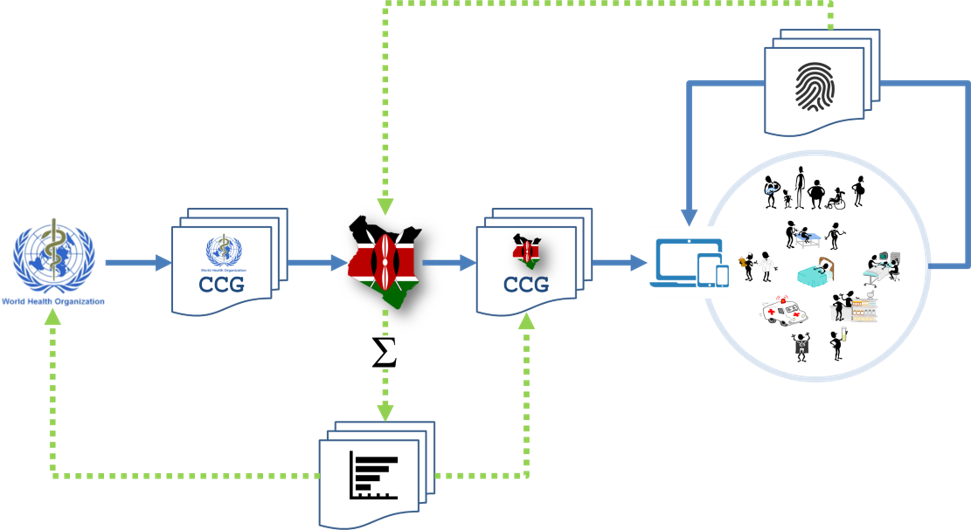Difference between revisions of "Computable Care Guidelines"
Derek.ritz (talk | contribs) |
Derek.ritz (talk | contribs) |
||
| Line 11: | Line 11: | ||
* the reportable health system management indicators that may be automatically generated from the person-centric healthcare transactions. | * the reportable health system management indicators that may be automatically generated from the person-centric healthcare transactions. | ||
| − | Importantly, CCG | + | Importantly, CCG provides us with a mechanism to '''track and monitor''' the care delivery activities (''what happened'') ''and'' it provides us with a mechanism to '''increase guideline-adherence''' by indicating what ''should happen''. In this way, it supports both feedback and feed-forward process control. |
[[File:CCG_workflow_PNG.png]] | [[File:CCG_workflow_PNG.png]] | ||
Revision as of 16:35, 20 May 2019
The Computable Care Guidelines (CCG) profile supports the expression of and sharing of health care guidelines in a grammar that can be ingested and understood by a software application.
Summary
The evidence shows that improved adherence to care guidelines can yield significant population health impacts. The Computable Care Guidelines (CCG) profile helps close what WHO calls the know-do gap; the sometimes wide chasm between what we know are the evidence-based best practices and what is actually done during health care encounters. To close this gap, CCG provides a standards-based way to describe and to share:
- the minimum data set (including coded content) that should be collected during an encounter;
- the "workflow logic" that is to be triggered based on collected content; and
- the reportable health system management indicators that may be automatically generated from the person-centric healthcare transactions.
Importantly, CCG provides us with a mechanism to track and monitor the care delivery activities (what happened) and it provides us with a mechanism to increase guideline-adherence by indicating what should happen. In this way, it supports both feedback and feed-forward process control.
It is expected that guideline-development organizations (e.g. WHO, CDC, Diabetes Canada) would create and publish CCGs. These CCGs may be contextualized by implementing jurisdictions (e.g. Kenya Ministry of Health) to create localized versions. The jurisdictional CCGs would be ingested by computer, tablet and phone-based digital health solutions to operationalize guideline-based care across the health system. The digital health solutions will generate person-centric records based on the CCG's minimum dataset; these will support care continuity and quality assurance. In a feedback loop, these data may be employed to develop and report analytics. The analytics will support management and continuous quality improvement of both the care delivery network and of the guidelines themselves.
Benefits
“Health care in all global settings today suffers from high levels of defects in quality across many domains, and this poor-quality care causes ongoing damage to human health. Hospitalizations in low- and middle-income countries (LMICs) lead to 134 million adverse events each year, and these adverse events contribute to more than 2.5 million deaths annually. More than 830 million people with a diagnosed noncommunicable disease (NCD) are not being treated, and more than 4 million avoidable quality-related deaths each year are attributable to ineffective care for NCDs. In total, between 5.7 and 8.4 million deaths occur annually from poor quality of care in LMICs for the selected set of conditions the committee analyzed… which represents between 10 and 15 percent of the total deaths in LMICs reported by the World Health Organization (WHO) in 2015. For some conditions, deaths due to poor quality contribute to more than half of overall deaths." (Crossing the Global Quality Chasm (2018))
Details
The CCG profile leverages IHE's Dynamic Care Planning (DCP) profile. Similar to DCP, CCG expresses the care guideline using the CarePlan, PlanDefinition, ActivityDefinition and Task resources defined in the HL7 FHIR standard. CCG particularly focuses on the definition of the minimum data sets needed to operationalize the evidence-based care and on the use of IHE's mobile Aggregate Data Exchange (mADX) profile to define reportable indicators that may be generated from these data sets. The mADX profile leverages the Measure and MeasureReport FHIR resources.
Systems Affected
- Guideline-development bodies will generate CCGs and publish them as FHIR bundles hosted on a FHIR server
- Jurisdictions will contextual CCGs and publish them as FHIR bundles hosted on a FHIR server
- Digital health solution developers will modify their applications to enable them to ingest CCGs, to operationalize a UI based on the minimum data sets and the care workflow logic, and to generate and report the management metrics (mADX messages) as defined by the CCG
Actors & Transactions:
TBD
Specification
Profile Status: In Development
Documents: TBD
Underlying Standards:
